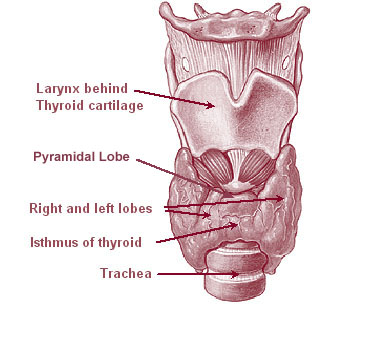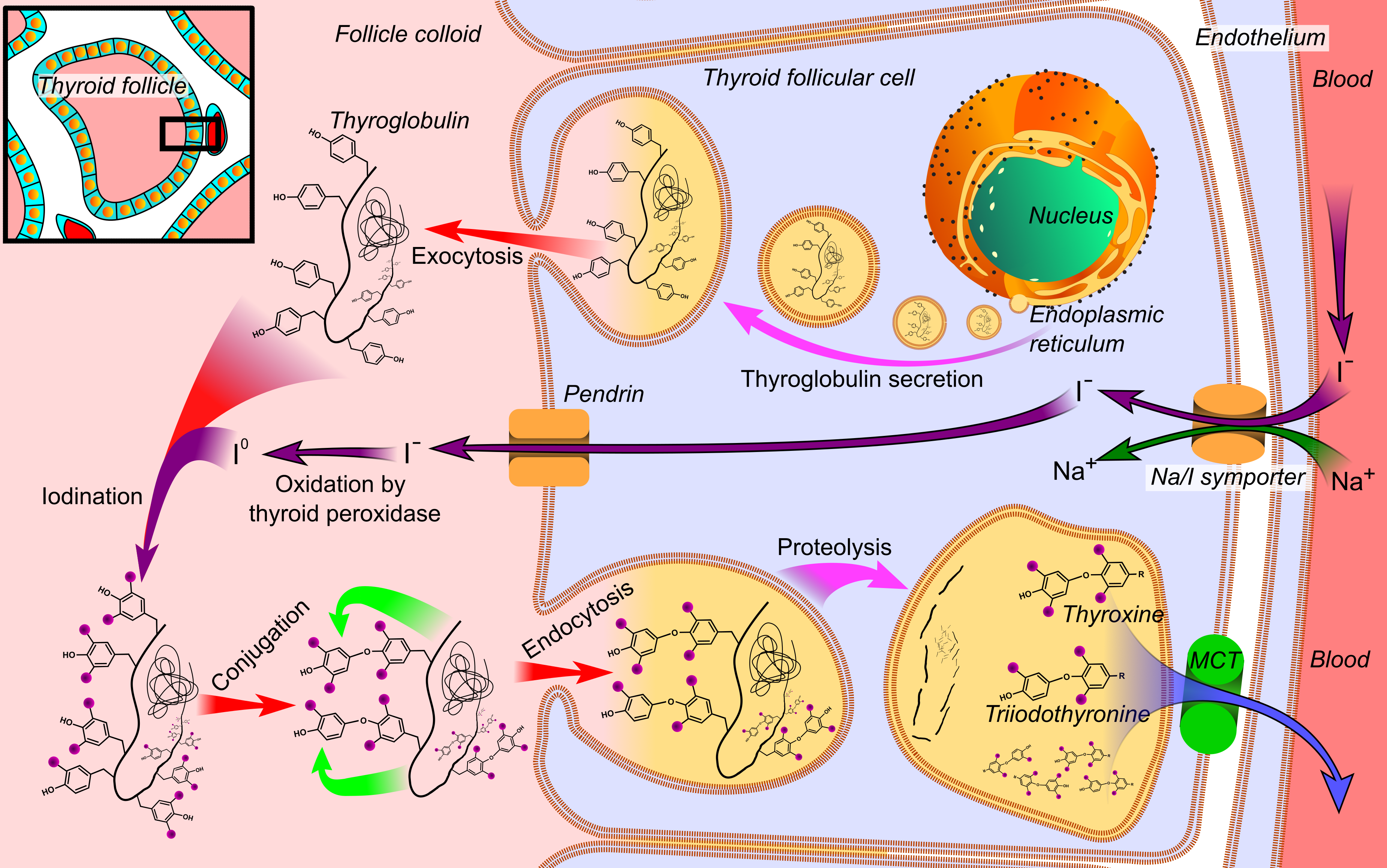|
Hyperthyroid
Hyperthyroidism is a endocrine disease in which the thyroid gland produces excessive amounts of thyroid hormones. Thyrotoxicosis is a condition that occurs due to elevated levels of thyroid hormones of any cause and therefore includes hyperthyroidism. Some, however, use the terms interchangeably. Signs and symptoms vary between people and may include irritability, muscle weakness, sleeping problems, a fast heartbeat, heat intolerance, diarrhea, enlargement of the thyroid, hand tremor, and weight loss. Symptoms are typically less severe in the elderly and during pregnancy. An uncommon but life-threatening complication is thyroid storm in which an event such as an infection results in worsening symptoms such as confusion and a high temperature; this often results in death. The opposite is hypothyroidism, when the thyroid gland does not make enough thyroid hormone. Graves' disease is the cause of about 50% to 80% of the cases of hyperthyroidism in the United States. Other caus ... [...More Info...] [...Related Items...] OR: [Wikipedia] [Google] [Baidu] |
Graves' Disease
Graves' disease, also known as toxic diffuse goiter or Basedow's disease, is an autoimmune disease that affects the thyroid. It frequently results in and is the most common cause of hyperthyroidism. It also often results in an enlarged thyroid. Signs and symptoms of hyperthyroidism may include irritability, muscle weakness, sleeping problems, a fast heartbeat, poor tolerance of heat, diarrhea and unintentional weight loss. Other symptoms may include thickening of the skin on the shins, known as pretibial myxedema, and eye bulging, a condition caused by Graves' ophthalmopathy. About 25 to 30% of people with the condition develop eye problems. The exact cause of the disease is unclear, but symptoms are a result of antibodies binding to receptors on the thyroid causing over-expression of thyroid hormone. Persons are more likely to be affected if they have a family member with the disease. If one monozygotic twin is affected, a 30% chance exists that the other twin will ... [...More Info...] [...Related Items...] OR: [Wikipedia] [Google] [Baidu] |
Thyroid Gland
The thyroid, or thyroid gland, is an endocrine gland in vertebrates. In humans, it is a butterfly-shaped gland located in the neck below the Adam's apple. It consists of two connected lobes. The lower two thirds of the lobes are connected by a thin band of tissue called the isthmus (: isthmi). Microscopically, the functional unit of the thyroid gland is the spherical thyroid follicle, lined with follicular cells (thyrocytes), and occasional parafollicular cells that surround a lumen containing colloid. The thyroid gland secretes three hormones: the two thyroid hormones triiodothyronine (T3) and thyroxine (T4)and a peptide hormone, calcitonin. The thyroid hormones influence the metabolic rate and protein synthesis and growth and development in children. Calcitonin plays a role in calcium homeostasis. Secretion of the two thyroid hormones is regulated by thyroid-stimulating hormone (TSH), which is secreted from the anterior pituitary gland. TSH is regulated by th ... [...More Info...] [...Related Items...] OR: [Wikipedia] [Google] [Baidu] |
Thyroid Storm
Thyroid storm is a rare but severe and life-threatening complication of hyperthyroidism. It occurs when an overactive thyroid leads to hypermetabolism, which can cause death from cardiac arrest or multiple organ failure. It is characterized by a high fever (temperatures often above ), fast and often irregular heart beat, elevated blood pressure, vomiting, diarrhea, and agitation. Hypertension with a wide pulse pressure occurs in early to mid crisis, with hypotension accompanying shock occurring in the late stage. Heart failure and heart attack may occur. Death may occur despite treatment. Most episodes occur either in those with known hyperthyroidism whose treatment has stopped or become ineffective, or in those with untreated mild hyperthyroidism who have developed an intercurrent illness (such as an infection). The primary treatment of thyroid storm is with inorganic iodine and antithyroid drugs (propylthiouracil or methimazole) to reduce synthesis and release of thyroid ... [...More Info...] [...Related Items...] OR: [Wikipedia] [Google] [Baidu] |
Methimazole
Thiamazole, also known as methimazole, is a medication used to treat hyperthyroidism. This includes Graves' disease, toxic multinodular goiter, and thyrotoxic crisis. It is taken by mouth. Full effects may take a few weeks to occur. Common side effects include itchiness, hair loss, nausea, muscle pain, swelling, and abdominal pain. Severe side effects may include low blood cell counts, liver failure, and vasculitis. Use is not recommended during the first trimester of pregnancy due to the risk of congenital anomalies, but it may be used in the second trimester or third trimester. It may be used during breastfeeding. Those who developed significant side effects may also have problems with propylthiouracil. Thiamazole is a cyclic thiourea derivative that works by decreasing the production of thyroid hormones. Thiamazole was approved for medical use in the United States in 1950. It is on the World Health Organization's List of Essential Medicines. It is available as a ge ... [...More Info...] [...Related Items...] OR: [Wikipedia] [Google] [Baidu] |
Synthetic Thyroid Hormone
File:Thyroid_system.svg, upright=1.5, The thyroid system of the thyroid hormones T3 and T4 rect 376 268 820 433 Thyroid-stimulating hormone rect 411 200 849 266 Thyrotropin-releasing hormone rect 297 168 502 200 Hypothalamus rect 66 216 386 256 Anterior pituitary gland rect 66 332 342 374 Negative feedback rect 308 436 510 475 Thyroid gland rect 256 539 563 635 Thyroid hormones rect 357 827 569 856 Catecholamine rect 399 716 591 750 Metabolism desc bottom-left Thyroid hormones are two hormones produced and released by the thyroid gland, triiodothyronine (T3) and thyroxine (T4). They are tyrosine-based hormones that are primarily responsible for regulation of metabolism. T3 and T4 are partially composed of iodine, derived from food. A deficiency of iodine leads to decreased production of T3 and T4, enlarges the thyroid tissue and will cause the disease known as simple goitre. The major form of thyroid hormone in the blood is thyroxine (T4), whose half-life of around one wee ... [...More Info...] [...Related Items...] OR: [Wikipedia] [Google] [Baidu] |
Thyroid Hormone
File:Thyroid_system.svg, upright=1.5, The thyroid system of the thyroid hormones triiodothyronine, T3 and T4 rect 376 268 820 433 Thyroid-stimulating hormone rect 411 200 849 266 Thyrotropin-releasing hormone rect 297 168 502 200 Hypothalamus rect 66 216 386 256 Anterior pituitary, Anterior pituitary gland rect 66 332 342 374 Negative feedback rect 308 436 510 475 Thyroid, Thyroid gland rect 256 539 563 635 Thyroid hormones rect 357 827 569 856 Catecholamine rect 399 716 591 750 Metabolism desc bottom-left Thyroid hormones are two hormones produced and released by the thyroid gland, triiodothyronine (T3) and thyroxine (T4). They are tyrosine-based hormones that are primarily responsible for regulation of metabolism. T3 and T4 are partially composed of iodine, derived from food. A deficiency of iodine leads to decreased production of T3 and T4, enlarges the thyroid, thyroid tissue and will cause the disease known as simple goitre. The major form of thyroid hormone in the blood ... [...More Info...] [...Related Items...] OR: [Wikipedia] [Google] [Baidu] |
Goitre
A goitre (British English), or goiter (American English), is a swelling in the neck resulting from an enlarged thyroid gland. A goitre can be associated with a thyroid that is not functioning properly. Worldwide, over 90% of goitre cases are caused by iodine deficiency. The term is from the Latin ''gutturia'', meaning throat. Most goitres are not cancerous ( benign), though they may be potentially harmful. Signs and symptoms A goitre can present as a palpable or visible enlargement of the thyroid gland at the base of the neck. A goitre, if associated with hypothyroidism or hyperthyroidism, may be present with symptoms of the underlying disorder. For hyperthyroidism, the most common symptoms are associated with adrenergic stimulation: tachycardia (increased heart rate), palpitations, nervousness, tremor, increased blood pressure and heat intolerance. Clinical manifestations are often related to hypermetabolism (increased metabolism), excessive thyroid hormone, an in ... [...More Info...] [...Related Items...] OR: [Wikipedia] [Google] [Baidu] |
Goiter
A goitre (British English), or goiter (American English), is a swelling in the neck resulting from an enlarged thyroid gland. A goitre can be associated with a thyroid that is not functioning properly. Worldwide, over 90% of goitre cases are caused by iodine deficiency. The term is from the Latin ''gutturia'', meaning throat. Most goitres are not cancerous (benign), though they may be potentially harmful. Signs and symptoms A goitre can present as a palpable or visible enlargement of the thyroid gland at the base of the neck. A goitre, if associated with hypothyroidism or hyperthyroidism, may be present with symptoms of the underlying disorder. For hyperthyroidism, the most common symptoms are associated with adrenergic stimulation: tachycardia (increased heart rate), palpitations, nervousness, tremor, increased blood pressure and heat intolerance. Clinical manifestations are often related to hypermetabolism (increased metabolism), excessive thyroid hormone, an increase in oxy ... [...More Info...] [...Related Items...] OR: [Wikipedia] [Google] [Baidu] |
Radioiodine Therapy
Iodine-131 (131I, I-131) is an important radioisotope of iodine discovered by Glenn Seaborg and John Livingood in 1938 at the University of California, Berkeley. It has a radioactive decay half-life of about eight days. It is associated with nuclear energy, medical diagnostic and treatment procedures, and natural gas production. It also plays a major role as a radioactive isotope present in nuclear fission products, and was a significant contributor to the health hazards from open-air atomic bomb testing in the 1950s, and from the Chernobyl disaster, as well as being a large fraction of the contamination hazard in the first weeks in the Fukushima nuclear crisis. This is because 131I is a major fission product of uranium and plutonium, comprising nearly 3% of the total products of fission (by weight). See fission product yield for a comparison with other radioactive fission products. 131I is also a major fission product of uranium-233, produced from thorium. Due to its mode of ... [...More Info...] [...Related Items...] OR: [Wikipedia] [Google] [Baidu] |
Thyroiditis
Thyroiditis is the inflammation of the thyroid gland. The thyroid gland is located on the front of the neck below the laryngeal prominence, and makes hormones that control metabolism. Thyroiditis is a group of disorders that all cause thyroidal inflammation. Symptoms, diagnosis and treatment depend on the cause of thyroiditis. Forms of thyroiditis are Hashimoto's thyroiditis, postpartum thyroiditis, subacute (de Quervain's) thyroiditis, silent thyroiditis, drug-induced thyroiditis, radiation-induced thyroiditis and acute thyroiditis. Types Hashimoto's thyroiditis is an autoimmune disease where the body creates thyroid antibodies. It presents with hypothyroidism due to the destruction of thyroid cells. In Hashimoto's thyroiditis, the hypothyroidism is most often permanent, with symptoms are fatigue, weight gain, depression, dry skin, and constipation. Thyroid hormone replacement is the treatment of hypothyroidism. Silent thyroiditis or painless thyroiditis, also ... [...More Info...] [...Related Items...] OR: [Wikipedia] [Google] [Baidu] |




